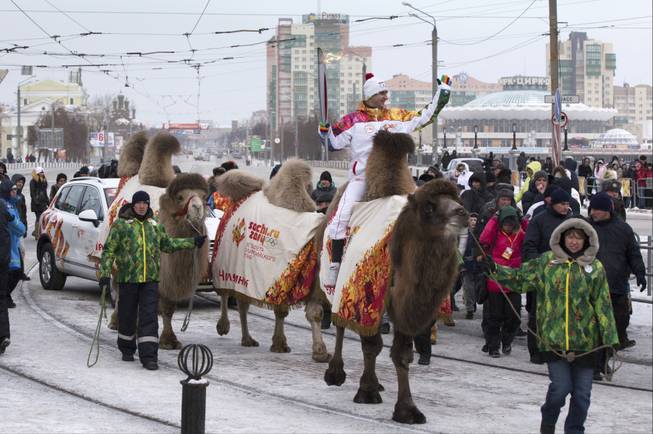
New York Times News Service
In a handout photo, Evgeny Zemskov, an Olympic torchbearer, rides a camel in Chelyabinsk, Russia, Dec. 17, 2013. The flame is being taken through all 83 of Russia’s regions and to some extreme locales during a 40,389-mile torch relay to Sochi, the longest in Olympic history.
Wednesday, Dec. 18, 2013 | 3:17 p.m.
It was bad enough when the Olympic flame went out and had to be relit with a disposable lighter rather than the official backup flame, and even worse when a torchbearer managed somehow to set himself on fire in the Siberian city of Abakan.
But perhaps the low point in what has seemed less like an Olympic torch relay than an exercise in ineptitude and misfortune came earlier this week when one of the runners carrying the torch to the Sochi Games had a fatal heart attack while attempting to walk his allotted distance, about 218 yards.
“He returned to the gathering place and was photographed, then said he was not feeling well and was taken to the hospital, but the doctors were unable to save him,” Roman Osin, a Sochi 2014 torch relay spokesman, told reporters of the man, a 73-year-old school sports director and Greco-Roman wrestling coach. “We express our deepest condolences to his loved ones.”
Maybe a few bad experiences are par for the course in an undertaking that, like many things about the Sochi Games, is built on superlatives - meant to be bigger, better and more thrillingly ambitious than any torch relay that has come before it. At about 40,000 miles, the route is the longest in Olympic history, winding through the North Pole, beneath the water in Lake Baikal and into space. Fourteen thousand people are taking part, the most ever, and they are traveling, variously, on foot, by plane, by train, by car, by snowmobile, by icebreaker, by jet pack, by zip wire, by sleigh, by horse and by camel.
The Russian authorities, who are hoping to use the games as a way to show off their country’s varied landscapes and superior organizational skills, naturally would like to present the situation in the most benign light.
For example, despite numerous reports and video evidence suggesting that the flame has died out perhaps as many as four dozen times, eight in the first six days of the relay, the official line is that it has stopped burning only something like three times so far, Osin said. And only once, he stressed in an interview, had it been relit by someone’s lighter.
“It was just a gust of wind,” he said of the incident, which took place in the Kremlin grounds, on the second leg of the 14,000-leg relay. “The torchbearer who was running was absolutely terrified and didn’t know what to do, and he asked the guard to help him, and the guard” - here he paused - “helped, with the only device he had.”
It is unclear what happened to the guard.
By the same token, Osin said, the flame had set people on fire only on three occasions, and never in a hazardous way. “It’s not dangerous,” Osin said. “It didn’t even damage the garments of the torchbearers.”
The Olympic flame is not eternal, but is relit a few months before each Olympics, said Bill Mallon, a former president of the International Society of Olympic Historians. It originates in the temple of Hera in Olympia, Greece, where it is ceremonially lit by “supposedly Greek virgin priestesses,” Mallon said, using the sun’s rays via a parabolic mirror.
The flame is then transported to the host country and sent on the relay, passed from torch to torch, with the backup flame traveling nearby in case of a sudden de-flaming emergency.
It is not as easy as it might look to be a torchbearer. For one thing, said JJ Fetter, an Olympic sailing medalist who has run in two torch relays, the thing is kind of heavy, and you have to carry it at an awkward angle in front of your body.
“You’re nervous about tripping, and you can’t run with your arm going backwards and forwards as part of your normal stride, because then you would be waving the flame around,” Fetter said. “You don’t want to set your hair or anyone else’s hair on fire.”
Russia is not the only country to have had relay glitches. The history of torch relays is also the history of torch mishaps, many of them coming when the flame finally reached the main Olympic stadium. In 1988, in Seoul, South Korea, several doves released in a dramatic gesture during the opening ceremony flew into the Olympic cauldron and roasted to death.
In the 1956 Winter Games in Cortina, Italy, the speedskater Guido Caroli glided into the arena on skates and then tripped over a microphone wire, ending up on his rear end, still clutching his torch. “He always said proudly that the flame did not go out,” Mallon said.
According to Osin, while experience indicates that organizers can generally expect to have a torch malfunction rate of 5 percent in the pre-Olympic relays, Russia’s rate has been just 2 percent.
Patrick Reevell contributed reporting from Moscow.

Join the Discussion:
Check this out for a full explanation of our conversion to the LiveFyre commenting system and instructions on how to sign up for an account.
Full comments policy